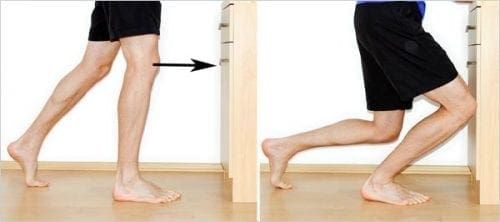Running Through It: Cate + Migraine Headaches

Cate, smiling and (maybe not nauseous?) after the Eugene Marathon.
[[Happily back to our Running Through It series; today, we hear from #motherrunner and writer Cate Hotchkiss and how she navigates the tricky line between running and migraines.]]
The evening before the 2017 Eugene marathon, I was reading a book in bed when suddenly, I couldn’t make out some of the words. They appeared to be blotted out by a small, dark oval with wavy lines, like a thumbprint. I blinked hard a couple of times and looked at a new paragraph, but the spot loomed, then started growing larger.
I placed the book in my lap and scanned the hotel suite. Wherever I looked—at the heavy drapes, the flat-screen TV, my race bib on the bedside table—pieces were missing, eclipsed by the big blemish, which was now shimmering. I knew I was having a migraine aura.
I got out of bed, fumbled through my purse for the hotel key card, and rushed to the bathroom where I dumped a Ziplock bag of toiletries onto the counter. I popped two ibuprofen and, with my empty bag, headed down the hallway in my pajamas to the ice machine. I packed the bag with ice. The shimmery oval morphed into a jagged, metallic starburst, like a speech bubble in a comic strip—one that says, Kapow!
I hurried back to the room, crawled into bed, placed the bag of ice on my forehead, and braced for the hard kick of the migraine: some degree of headache, nausea, dizziness, and fatigue that would last from a few hours to a couple of days. Even though I’ve suffered from migraines for more than two decades, I never knew what I’d get.
But first, and for the next 20 minutes before the aura burned out, I’d watch a stream of brilliant starbursts light up the dark.
***
If you get migraines, you know that they’re not just severe headaches. Migraine is a genetic, neurological disorder with a host of symptoms that can affect your entire body. A recent study shows that worldwide, it’s the third most disabling disease in people under 50. And, among all ages, it ranks in the top 10.
Migraines afflict 36 million people in the U.S., and one in five women, according to the American Migraine Foundation. Furthermore, women are three times more likely to suffer them than men. Approximately 30 percent of people with migraines experience auras, or temporary disturbances in visual, sensory, motor, or verbal functioning.

Cate’s dog, Harper, and daughter, Amelia: a great pic amidst migraine yuck.
My migraines started in my early 20s, but fortunately, for most of my life, they weren’t chronic. I’d get four or five a year—disruptive and painful, but manageable. However, in my mid-40s, likely due to hormonal changes, they hit weekly and now included (bonus!) disabling vertigo. It took months of trial and error to find the right cocktail of meds and other therapies to mitigate the attacks and symptoms.
And yet, sporadically they still strike—like the one did the night before the Eugene marathon.
***
When the alarm sounded at 4 a.m., the worst of the head pain had subsided, and I wasn’t dizzy—a big win. However, the nausea was intense and I was skeptical I could run through it, especially at a pace that would qualify me for Boston.
Nonetheless, I got up, brewed a small pot of coffee, and heated up a bowl of oatmeal. I wanted to call my husband, my sounding board, for support, but he’d still be sleeping. He usually joined me at races, but our two kids had too much going on that weekend for both of us to be out of town.

Cate and her other child, John in the great outdoors.
Instead, I turned to writing, as I often do, to help sort out my racing thoughts. I opened my laptop and journal file. At the top of the page, I’d pasted a quote by one of my running heroes, Olympian Kara Goucher, which reads: “There are a million reasons why you can’t. Focus on the few reasons why you can.” I decided to write a short list of why I can:
- I’ve trained hard and, at times, through migraine symptoms, too.
- I’ve run six marathons. My body knows how to do this.
- If I throw up on the course, I certainly won’t be the only one.
But when I started to write how I’d feel if I didn’t run, I stopped. My body tensed up. If a migraine equaled no race, what would it take from me next? I flashed back to those 18 months when simply getting out of bed each morning was a torment; when I felt as if I were failing in every role—as a mother, wife, friend, writer, runner—and when I wondered if I’d ever feel good again. I didn’t want to go back there.
I closed my laptop. I pinned on my bib. And, at 5:45 a.m., I boarded the shuttle bus to the race.
An hour later, I was shivering in front of Hayward Field in corral C with all the other nervous runners wearing shorts in 39 degrees. When the gun fired, we moved together as a pack before fanning out and finding our own paces. Mine was slower than what I’d trained for, and from the initial strides, I felt like hell.
I was hoping, though, that after the first few miles, things would improve. They didn’t. The nausea was unrelenting, and my body heavy, as if it were being pressed into the pavement.

Another great Cate pic; guessing her head is feeling clear + free in the mountain air.
I took several deep breaths and tried to smile, as if to trick my body into thinking it felt good, a strategy I learned from my dear friend, Alicia, who ran the NYC marathon with a stress-fractured foot. By the 10-mile mark, the nausea had abated enough to pick up the pace, and aside from my sludgy legs, I felt okay. Maybe, I thought, I could still meet my B goal of finishing in under four hours.
Unfortunately, while cruising on the shaded bike path alongside the Willamette River, I hit the wall hard at mile 20, which triggered a tidal wave of nausea. At the next aid station, I took off my hat and dumped a cup of water on my head. But the heat wasn’t the problem, and the water only streaked my sunglasses and streamed salt into my eyes.
At that point, I just wanted to walk, or better yet, sit under a giant shade tree.
But then a runner who appeared to be at least a decade older came zooming by me. I thought, damn, if she can do it, and which inspired me to keep scuffling from aid station to aid station until I managed to pick up my feet for the last half mile and kick through the final stretch into Hayward Field.
I crossed the finish line in 4 hours and 6 minutes, neither meeting my A nor B goal, but that hardly mattered. What did matter: I now had a bib whose numbers were obscured only by a solid, shimmery medal.
Have you Run Through It—a challenging situation or stage in life—at some point? We want to hear from you!
Write up your essay (no more than 1,200 words, please), then email it to us. We’ll be in touch when we can publish it. Thanks!
Day in the Life of Another Mother Runner: Kat Schjei + Kate Walton
Happy to announce we’re bringing back a popular feature: Day in Life of Another Mother Runner, a day where we hand over our Instagram account to another mother runner and let her document her day.
We’ve had two awesome BAMRs already share pieces of their lives: Kat Schjei + Kate Walton. Check them out—and if you’re interested in doing the same, follow the instructions at the end of the post.
SLICES FROM A DAY IN THE LIFE OF ANOTHER MOTHER RUNNER
KAT SCHJEI (@SMUSHTUSH)
SLICES FROM THE DAY IN LIFE OF ANOTHER MOTHER RUNNER
KATE WALTON
If you’re interested in taking over our account for a day, we’d love to have you. You can be training, injured, inspired, not so much, a beginner, a marathoner…as long as you want to open the door to your #motherrunner world, we’d love to come on in and look around.
Please email us and we’ll get you set up!
AMR Aid Station: Why Do I Get Holes in the Toes of My Running Shoes?
Welcome to the AMR Aid Station, a new feature on the Another Mother Runner. At the AMR Aid Station, we will answer and explain your burning + interesting #motherrunner questions, so if you have any, feel free to tweet us @themotherrunner with your question and use #AMRAidstation; you can also comment in below or email us.
Why do I get holes in the toes of my running shoes?

Collette’s shoes.
“Every pair of running shoes I’ve ever owned end up looking like this. Any suggestions to either fix the problem or reinforce the toe? They feel great, never had a black toenail, no problems with toe box. I try to not heel strike. Yes, I keep my toenails cut short.” Colette asked on Another Mother Runner’s Facebook page.
As it happens, I asked this very same question two years ago in van at Ragnar Relay Cape Cod with a bunch of (former) colleagues from That Running Magazine Where I Used to Work, including long-time running-shoe wrangler Warren Greene and gear editor Jeff Dengate.
Jeff made quick work of the problem, telling me my shoes were too short and my toenails too long. Jeff also brought a folding chair along for the 24-hour-plus relay, which you probably know involves long stints of waiting for your turn to run.

RW Gear Editor Jeff Dengate showed off his foresight at the 2016 Cape Cod Ragnar Relay.
Jeff said: “Holes in the toe box of running shoes is a quite common problem.”
Jeff: “It has to do with a number of factors, including the thin, breezy mesh that manufacturers use in the area to allow heat to escape. If you have long toenails or inflexible toe joints, you can rub against the inside of that mesh and wear a hole quickly. One solution: Keep those nails trimmed. Another is to visit your local running shop to be sure the shoes you’re wearing actually fit you properly, and to ensure you have enough volume (space all around your foot) for a comfortable fit.”
(Jeff speaks like the shoe geek that he is in real life. True story.)
Okay, but Colette SPECIFICALLY said she keeps her toenails trims and does NOT have problems with the toe box.
Turns out Colette’s problem may be with lack of ankle dorsiflexion. Ohhhhhhhhh. Wait. Huh?
Christine Diller was one of the mother runner physical therapists who weighed in on the AMR Facebook post with that diagnosis.

Christine, looking like the BAMR she is.
Christine was a track star in high school and college in Fort Recovery, Ohio, where she still lives. In addition to her physical therapy practice, she coaches middle and high school runners, runs half-marathons and marathons, including the Boston marathon with her sister last year, and has four kids ranging in age from 7 to 14.

Sisters Pamela Ranly (left) and Christine Diller (right) after the 2017 Boston Marathon.
Christine explains: Ankle dorsiflexion means being able to bend your foot up toward your shin, which is important in the transfer of weight while running, when you land on your heel to push off from your toes.
If your motion is limited in this direction, you may try to “help” the motion by extending the toes, in an (futile) effort to get your the ankle to bend more!
This could cause the big toe to rub on the top of the shoe. Ah ha!
And because our runner’s bodies are one big connected kinetic change, other issues could result too.
“If you are lacking range of motion, you may compensate in other ways, in the hip and knee, to try to get your body weight forward as you’re swinging your leg forward,” says Curtis Wu, a physical therapist with the Hospital for Special Surgery in New York City and a runner himself. “People might turn their hip out, instead of tracking straight forward, of their knee might collapse in. [Holes in the toes of your shoes] is a predictor of runner’s knee.”
Here’s a neat test you can do to text your ankle dorsiflexion, or range of motion:
Position yourself facing a wall one foot four inches from the wall. Lower yourself into a squat, trying to touch the wall with your forward knee, keeping the heel of your bent knee still flat on the ground.
Can you do it? Yay! You probably have enough range of motion—and the tops of your shoes are in tact.
If your heel comes up or your knee doesn’t meet the wall, Christine says, your motion is limited.
One potential cause: Your calf muscles are too tight.
Solution: Christine recommends two common stretches to get the two main calf muscles that contribute to ankle stiffness. She says do this AFTER exercise, when your muscles are warm, and to hold the each stretch for 3-4 minutes—an eternity in stretching time, btw—four to five times weekly.
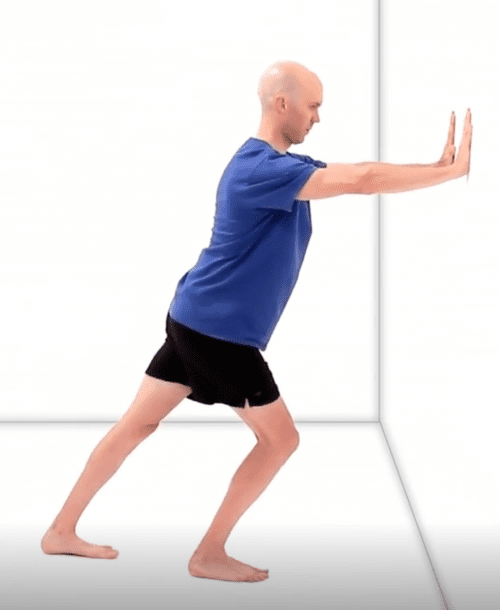
First stretch: Push against wall with your back knee straight, front knee slightly bent. Stretch is in the calf of the back leg.
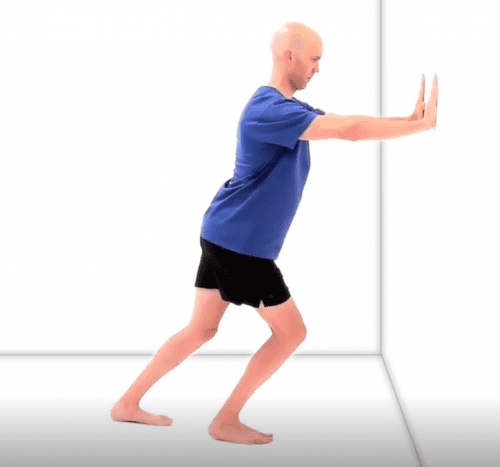
Second stretch: Push against wall with your back knee slightly bent, front knee slightly bent. Stretch is in lower calf of the back leg. Switch legs and repeat sequence.
Another important solution for tight calves: Foam Rolling! Break out the TriggerPoint! It’s especially imoportant to target your calves, but your entire leg needs some love too. Christine is a huge fan of Coach MK’s Foam Rolling Video (Yes, it hurts, but yes, it’s worth it! Promise!).
Second potential cause: Lack of mobility.
If you feel tightness or stiffness in the front of the ankle during your dorsiflexion test, Christine says you need to work on mobilization.
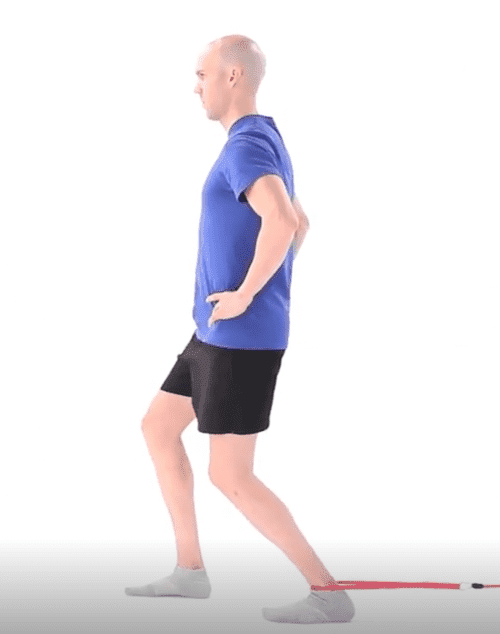
Increase ankle mobility: Wrap a thick band around the front of your ankle and anchor it behind you. Step that foot forward so there is a bit of resistance in the band, and while keeping your heel flat, bend the knee and let the shin come forward. Hold for two seconds. This is a small, finesse movement– not a power movement! Do 2 x 10 reps three times a week.
Third Potential Cause: Weak Glutes.
Of course, back to Colette and her toe holes, the problem may not be in her ankles at all. They may originate higher up the kinetic chain, with weak glutes causing the calf muscles to work overtime. (In running, everything always comes back to weak glutes.)

One of Christine’s favorite glute exercises. Get in the pigeon pose. Squeeze glutes and then lift knee off of table, keeping toes on the table/floor. Lower knee back to table and repeat, making sure glutes are firing and engaged.
“I usually have runners perform this for one minute at a time on each leg,” she says, “So you squeeze the glute, lift the knee. Return to start, and repeat for up to one minute. This way you can concentrate on getting a good glute squeeze and not on counting!”
Do your running shoes have holes in the toes of them? How is your ankle dorsiflexion? We want to know!
#302: The Lowdown on Feeling Rundown
Sarah and co-host Amanda Loudin welcome Dr. Lisa Corbin, a professor at University of Colorado School of Medicine and a mom of three, to discuss the causes—and cures—of feeling rundown. As in, what to do when your get up and go has got up and went! Dr. Lisa suggests when it’s time to see a doctor about low energy, plus other symptoms to take into consideration. She shares “grandma tips” for improving sleep along with recommending a great online resource. The trio talk about anemia—the various types, as well as the cures. The good doc details signs of hypothyroidism (even after SBS repeatedly botches pronunciation of the condition!); she also says why a mother runner might still feel draggy even after getting thyroid issues back in line. Hear the pros + cons of multivitamins. This episode’s Nuun drinking game: Chug at any mention of Betty Who!
In the intro, find out a little-known fact about Amanda’s past athletic life! The expert joins the convo at 15:00.
Enter to win an entry to the 2018 New York City Marathon + a $500 travel stipend, courtesy of Strava. Go to strava.com/nycmarathon to enter and read the official rules. And join the AMR Club on Strava!
Get $35 off your first Sun Basket order by going to SunBasket.dom/AMR
Dry Martini: Once More, onto the Beach
Sometimes, life hands you exactly what you need. And what I needed, it turns out, was two hours in a porch swing with a book and a blanket after having run 13.1 miles with six of the best BAMRs ever.
But let me back up.

I made a new friend in Edinburgh.
When last we spoke, I was in Scotland on a family vacation. I ran for exactly zero minutes while in the U.K. While I had the intellectual desire, my body just did not want to. The jet lag really kicked my heiner this time — I’m told it is because I’m getting older but I’ve decided to live in denial on that one — and I never felt quite right. I’ve also been dealing with some general tummy troubles — the details of which no one wants to hear, especially while eating.
So far, my armchair diagnosis has ranged from late-onset lactose intolerance to an ulcer to gall stones to your more exotic cancers. Yes, I’m going to a doctor tomorrow.

I found this two pence while making a coffee run. Does that count?
After we got back, I managed about six easy miles. Not six all at once, mind. Then it was time to repack and head to Florida for the Seaside School Half Marathon, after I made a small stop in Orlando to visit my Mom.
Because of my relationship with Voldesun (spoiler alert: I hates it), I’ve never been a big beach person. If I must beach, I tend to gravitate towards those with boulders and crashing, cold water. This whole white sand and tranquil blue is not really my bliss. However, when there are BAMRs involved, I’m easy to persuade. For the record, Seaside is perfectly lovely. Standing in sugar sand while your husband is texting about the 20” of snow that fell at home overnight is, in fact, priceless.

This isn’t snow.
The weekend exists in its own little bubble of wonderful, one that I’ll keep tucked near my heart for those moments that are less than wonderful. Saturday morning was filled with a long, rambling conversation about imposter syndrome and complicated mothers while we ate home-baked scones. Lisa, the Scone-ista, brought her own special scone whisk. Heidi made Shalane and Elyse’s lasagna, which I couldn’t stop shoving in my face. We all took turns with the clean-up and the random errands that pop up, like a mid-afternoon tampon run.
After the race, the majority of the crew schlepped to the beach, which I lacked the oomph to accomplish. The trans-Atlantic travel, coupled with the nearly seven hour drive from Orlando to Seaside (traffic was terrible), finally caught up with me. I took to the porch swing, read for a bit, napped for a bit, then repeated the cycle. It was absolutely what I needed. I am a lucky, lucky woman.

When you run across a bridge, take a picture. That’s, like, a rule.
As for the race itself, it was perfectly fine. The course is an out-and-back down 30A, which parallels, mostly, the Gulf. It had a hill or two but nothing crazy, if you are used to running in a place with any topography. The weather was kind and stayed in the 50s for most of my 13.1 miles. I found it too sunny but, again, I have issues.
At the end of the race — I ran across the finish line with a friend I don’t see nearly enough — I was handed a medal, a Vera Bradley bag, and a chicken and biscuit sandwich. Would that all runs ended like that.
Did I win my age group? Was it one of my slowest half-marathons ever? Did I enjoy the heck out of the race anyway? Another spoiler alert: nope, yup, and, indeed.
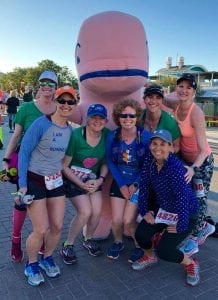
The whale declined to tell us his/her finish time.
Then, at 3 a.m. I drove to the airport and flew home. Boy, are my arms tired … from scraping the ice off of my windshield after I landed in Albany. It’s helpful to know that it is warm somewhere, though, even if it isn’t where you are.
Lisa and I will see each other again soon for the Seneca Seven, which is a relay race around Seneca Lake at the end of April. Before that, I’ll running the Cherry Blossom Ten-miler in D.C. It’s a bucket list race for me and I couldn’t pass up the opportunity. Any BAMRs want to come to a low-key meet-up before the Blossom? I can’t promise it will have all of the good vibes of a beach weekend but I might have some swag….
Question of the week: do you have any running-related moments that you flash back to when life gets bumpy?
Cheaper Than Therapy?
If you’re a runner, you know well the phrase “running is cheaper than therapy.” As someone who has been at it for 20 years and who writes frequently about the intersection of science and exercise, I agree with the sentiment–to a point.
I am fortunate enough to say I’ve never suffered from depression, anxiety or other type of mental illness. But I am two months removed from losing my mother; this, less than one year after my father’s passing. For the first time in my life, I am on the struggle bus.
Layered on top of this is a third, impending loss: my son just turned 17 and is a junior in high school. We’re touring colleges, he’s spreading his wings, and I simply do not want to face the day he leaves for school.
In the midst of this seemingly insurmountable pile of sadness, I am doing all the right things. Radical self care: I get up and run as planned. I spend time with friends. I take the dog for walks. I unplug from social media and crack open books that serve to transport me to another world. Writing and writing some more: essays and assignments, and free writes with two friends on our bi-weekly dates for just this purpose.
These actions are undoubtedly helping me. I shudder to think where I would be if I weren’t taking these steps. If I didn’t get out at sunrise and hear the birds, see the peaceful deer along my route and enjoy my dog’s smile as she runs alongside me. If I didn’t allow my voice to crack with emotion when running with my friends. I am grateful for a body that can carry me through these restorative miles, and the realization that I need these runs like oxygen right now.
So yes, running is a form of therapy for me, I know this. It is a crucial part of my healing process.
But I think it’s important that all of us remember that it can’t be a cure all. We can’t expect running—as wonderful and as valuable as it is for us—to take care of everything that ails us. It’s a piece of the puzzle, snugly fitting in with so many other important types of care.
When you’re as sad and emotionally raw as I find myself now, you have to throw everything at it. Each one of the steps I’m taking plays a critical role in the process. It’s my own chicken soup for the soul, and my advice to anyone who winds up in this place is to figure out your ingredients and start mixing.
Not every day is an emotional roller coaster and some weeks I have glimmers of my normal, optimistic self. But when the tough moments rise up, I’m trying all the things I know bring me comfort and joy. I give myself the grace to allow time to work its magic. In the meantime, I’ll run and write and read and reach out, and do it all again until I arrive at a place of healing.











